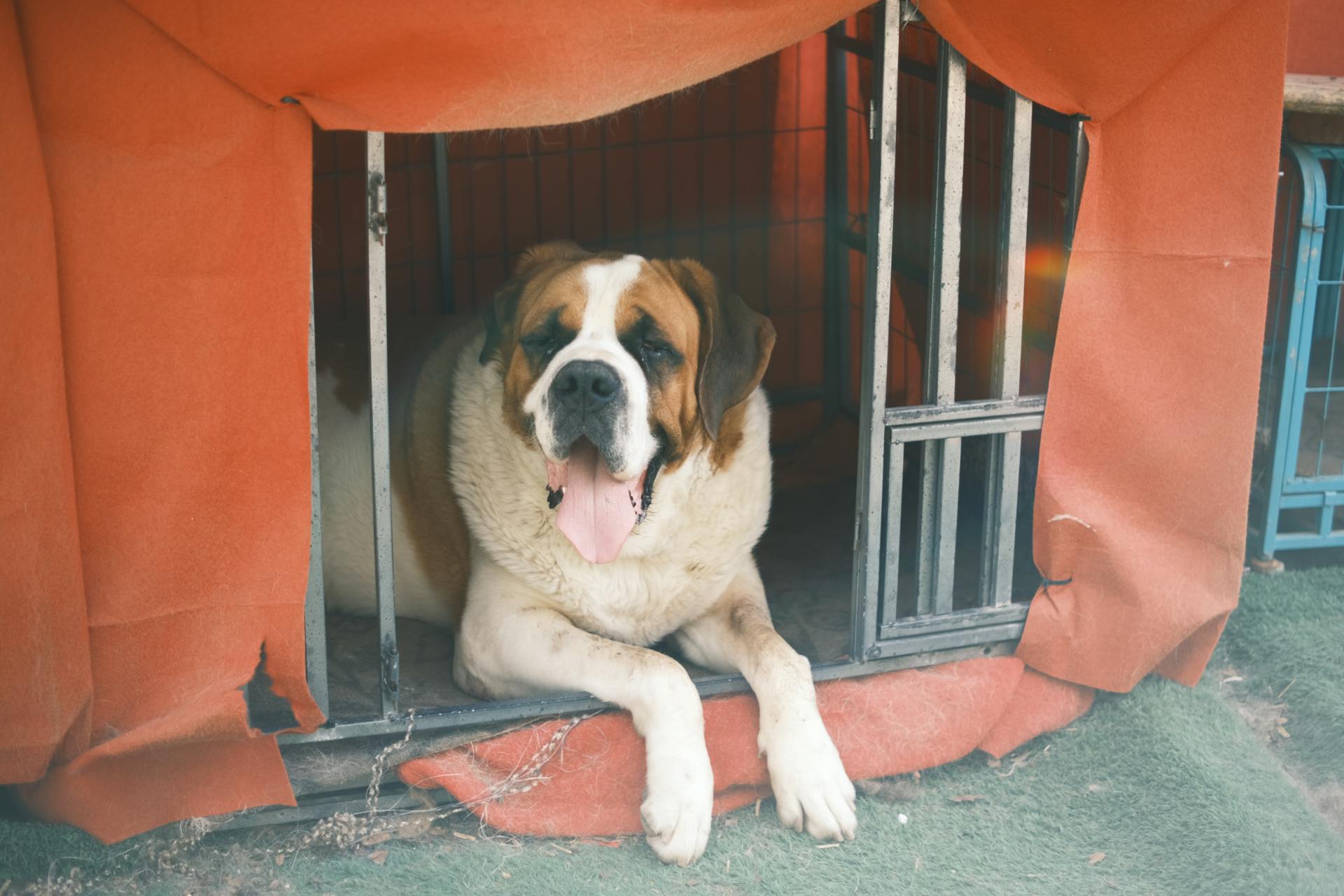
The Saint Bernard and English Mastiff are two giant breeds that have captured the hearts of many dog lovers. Saint Bernards originated in the Swiss Alps to assist in search and rescue missions.
Both breeds are known for their massive size, with Saint Bernards weighing between 120-180 pounds and English Mastiffs weighing between 130-230 pounds. However, English Mastiffs are generally taller, standing between 23-28 inches at the shoulder compared to Saint Bernards' 26-30 inches.
Physical Characteristics
The Saint Bernard and English Mastiff are two of the largest dog breeds in the world. Both breeds have distinctive physical characteristics that set them apart.
The Saint Bernard typically weighs between 120-180 pounds, making them a sturdy and robust breed. They have a thick double coat that sheds heavily, requiring regular grooming.
The English Mastiff is even larger, with males weighing up to 230 pounds and standing as tall as 30 inches at the shoulder. Their broad, flat heads are a defining feature of the breed.
The Saint Bernard's coat is reddish-brown in color, while the English Mastiff's coat is fawn or brindle. Both breeds have a short, easy-to-maintain coat, which is a plus for busy owners.
Recommended read: English Mastiff Coat
Temperament and Personality
Saint Bernards and English Mastiffs are both known for their loving and affectionate nature. They make great family pets and are often described as gentle giants.
Both breeds are happy to share their space with their families, and they'll often take over the best seats in the house. However, while Saint Bernards are friendly with everyone, English Mastiffs are a bit more aloof with strangers.
English Mastiffs are naturally protective of their families and have a bellowing bark that can be quite intimidating. On the other hand, Saint Bernards are known for their kind and good-natured nature, and they're often called "nanny dogs" because of their gentle demeanor around children.
In terms of sensitivity, English Mastiffs have an average emotional level and are not the most sensitive breed. Saint Bernards, on the other hand, are considered sensitive dogs.
Here's a comparison of the two breeds' temperament and personality traits:
Both breeds are generally good with other family pets, but they do need to be socialized well as puppies. With proper training, they can get along with smaller animals, but it's essential to teach them how to play gently.
Health and Care
Both Saint Bernards and English Mastiffs are prone to certain health issues that need attention. Regular check-ups with a vet are crucial for early detection and proper management.
Saint Bernards are particularly susceptible to hip and elbow dysplasia, bloat, and heart problems, so a balanced diet and regular exercise are essential. They also need regular brushing to prevent matting, and their facial folds and ears should be cleaned often.
Here are some common health issues to watch out for in both breeds:
- Hip Dysplasia: A common orthopedic condition in large breed dogs.
- Bloat: A life-threatening condition that can lead to Gastric Dilatation-Volvulus (GDV).
- Entropion: A condition where the eyelid rolls inward, causing discomfort and pain.
Both breeds are also sensitive to heat and can easily overheat, so it's essential to provide them with shade and fresh water, especially during hot weather.
Diet and Weight Management
When it comes to feeding your Mastiff or St. Bernard, it's essential to understand their dietary needs. Both breeds require a lot of food, and if you don't pay attention to their weight, they can easily gain weight.
A Mastiff needs 8 to 10 cups of high-quality dry food a day, divided into two meals, which is more than the St. Bernard's 6 to 8 cups. This is a significant difference, and you should consider this when planning your dog's meals.
Recommended read: English Mastiff and St Bernard Mix

Both breeds are prone to obesity, so it's crucial to monitor their weight closely. If you don't, they can easily become overweight, which can lead to serious health problems.
To help you keep track, here's a comparison of their daily food consumption:
By understanding their dietary needs and monitoring their weight, you can help your Mastiff or St. Bernard live a long and healthy life.
Health and Care
Mastiffs are generally healthy dogs, but like all breeds, they can be prone to certain health issues. Hip Dysplasia is a common problem in large breed dogs, including Mastiffs.
Hip Dysplasia occurs when the head of the thigh bone doesn't fit flush into the hip joint, causing inflammation and pain within the joint. Regular check-ups with a vet are crucial for early detection and proper management.
Mastiffs can adapt to cold weather conditions, but they can be sensitive to heat. They need full access to shade and fresh water, especially during hot weather.

St. Bernards, on the other hand, are prone to hip and elbow dysplasia, bloat, and heart problems. They also have a dense double coat that needs regular brushing to prevent matting.
Here are some common health issues that can affect both Mastiffs and St. Bernards:
Both breeds need a specific balanced diet to support their growth and bone health. Be cautious of overfeeding to prevent obesity, which can put extra strain on their joints.
Grooming
When it comes to grooming, both Mastiffs and St. Bernards have dense coats that require regular attention. The Mastiff's dense coat is easy to maintain, but it still sheds moderately.
St. Bernards, on the other hand, have a double coat that sheds heavily twice a year. They need to be brushed once or twice a week, and an occasional bath will help keep their coat and skin clean.
Brushing your St. Bernard's coat regularly can help reduce shedding and prevent hair from getting all over your clothes and furniture. Daily teeth brushing and frequent nail clipping are also essential to keep your St. Bernard's teeth and nails healthy.
Both breeds require regular grooming to prevent ear infections, as their large ear canals can be prone to infections if not cleaned regularly. St. Bernards need their ears cleaned every 2-3 weeks, while Mastiffs don't have specific ear cleaning requirements mentioned in the article.
Here's a rough guide to the grooming needs of both breeds:
It's worth noting that both breeds can be prone to tear staining, so it's essential to wipe their eyes regularly to prevent this issue.
Trainability and Intelligence
When training a Saint Bernard or an English Mastiff, you'll need to be patient. Both breeds have average to low intelligence, which means they may not pick up tricks or commands as quickly as other dogs.
Saint Bernards are slightly harder to train than average, so be prepared to put in extra effort to get them to listen. On the other hand, English Mastiffs are quite easy to train.

Here's a quick comparison of the trainability of both breeds:
Keep in mind that every dog is different, and with patience and consistency, you can still teach your Saint Bernard or English Mastiff new tricks. Just remember to be patient and reward good behavior.
Ownership and Cost
When considering bringing a Saint Bernard or an English Mastiff into your family, you'll want to think about the costs involved. The average price of a Saint Bernard puppy is around $1,000 to $1,500, while an English Mastiff can cost between $1,200 and $2,000.
Both breeds have relatively high maintenance costs due to their large size, with Saint Bernards requiring a diet of around 4-5 cups of food per day and English Mastiffs needing up to 6-8 cups.
Price and Availability
If you're considering bringing home a Mastiff or a St. Bernard, you'll want to think about the cost.
The price of a Mastiff is relatively affordable, ranging from $1200 to $1500.

The St. Bernard, on the other hand, is a bit pricier, with a range of $1500 to $1800.
Both breeds are quite easy to get, with the Mastiff being very frequent and the St. Bernard also being very frequent.
Here's a quick comparison of the prices and availability of the two breeds:
Choosing the Right Breed
If you're looking for a loyal and loving companion, the St. Bernard and Mastiff are excellent choices. Both breeds are well-suited for families with kids, but their size can be a hazard for tiny tots.
Owning a large breed like these two requires early training and socialization, a large space, and a family who can be at home with them. Early training is key to preventing accidents and ensuring a smooth transition for both you and your new pet.
A Mastiff is a safer choice for families who love spending time in their garden, as St Bernards tend to dig. On the other hand, St Bernards are a better fit for families who enjoy hiking and camping.
If you're intolerant of heavy drooling, a St Bernard might be the way to go.
Here's an interesting read: Saint Bernard Large Dogs
Bite and Safety
The bite and safety of a Saint Bernard versus an English Mastiff is a crucial aspect to consider when deciding which breed is right for you. The Mastiff has a bite force of above 400 PSI, making it one of the strongest bites among dog breeds.
The biting potential of both breeds is moderate, which means they have an average chance of biting somebody. This is not necessarily a cause for concern, but it's essential to be aware of their potential.
Mastiff dogs have a higher tendency to nip, chew, playbite, or herd people, which can be a challenge for some owners. On the other hand, the St. Bernard's biting potential is also moderate, but we don't have more information about their mouthiness.
If you're looking for a dog with a strong bite, the Mastiff is a clear winner, but it's essential to consider their mouthiness and biting potential.
Readers also liked: English Mastiff Bite Strength
Recognition and Comparison
Both Saint Bernards and English Mastiffs are massive breeds, but they have distinct differences in terms of their size. Saint Bernards typically weigh between 120-180 pounds, while English Mastiffs can weigh up to 230 pounds.
One of the most noticeable differences between the two breeds is their coat type. Saint Bernards have a thick, rough coat that sheds heavily, while English Mastiffs have a short, smooth coat that sheds minimally.
In terms of lifespan, Saint Bernards have an average lifespan of 8-12 years, whereas English Mastiffs have an average lifespan of 7-10 years.
You might like: Average Lifespan English Mastiff
Reproducibility
Reproducibility is a crucial aspect to consider when comparing breeds like Mastiffs and St. Bernards. Both breeds have a similar gestation length of 60-64 days.
A key factor to note is that both breeds have a litter frequency of once a year. This is essential to maintain the health of the mother and puppies.
Here's a comparison of litter sizes between the two breeds:
Breeding more frequently than once a year is not healthy for either breed. This is a crucial consideration for responsible dog ownership.
Recognition
The American Kennel Club (AKC) recognizes both Mastiffs and St. Bernards as Working breeds, having done so since 1885.

Both breeds are not recognized by the FCI, which is a significant distinction between the two.
The AKC is not the only organization to recognize these breeds, as they are also recognized by several other kennel clubs and registries, including the American Canine Registry, the Canadian Kennel Club, and the United Kennel Club.
Here's a list of some of the other organizations that recognize Mastiffs and St. Bernards:
Popular Dog Compares
If you're looking for a dog that's both energetic and intelligent, the German Shepherd and Doberman Pinscher are two breeds that stand out from the rest. They're both high-energy dogs that require regular exercise and mental stimulation.
One of the key differences between these two breeds is their size. The German Shepherd is generally larger than the Doberman Pinscher, with males weighing up to 95 pounds compared to the Doberman's 80 pounds.
If you're looking for a breed that's easy to train, the German Shepherd is a great choice. They're highly intelligent and respond well to positive reinforcement training.
In contrast, the Doberman Pinscher is also intelligent, but they can be more challenging to train due to their independent nature.
If you're looking for a breed that's perfect for families, the German Shepherd is a great choice. They're loyal and loving, making them a great addition to any family.
Here's a comparison of the two breeds:
Keep in mind that every dog is an individual, and it's essential to spend time with a potential new pet before making a decision.
Frequently Asked Questions
Is English Mastiff the strongest dog?
English Mastiffs have a remarkable bite strength of 556 psi, making them one of the strongest-jawed breeds. Their massive size and powerful jaw muscles contribute to their impressive bite force.
Featured Images: pexels.com

